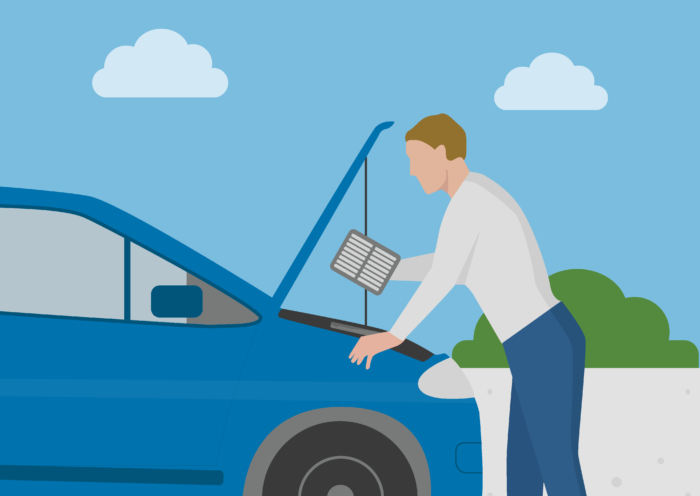Doing everything you can to reduce your car’s carbon emissions is not only about improving its performance or helping the environment, it can also mean the difference between a pass and fail on your annual MOT. Although CO2 emissions testing has been part of the MOT test in some form or another since 1991, in more recent years there has been a tightening of the rules when it comes to acceptable car emissions levels, leading to more emission-related ‘Dangerous’ and ‘Major’ faults being issued.
But what are the best ways to reduce your vehicle's emissions? What role do catalytic converters play in this process, and how can you check if your car’s catalytic converter is not working correctly ahead of your next MOT? Read on to find the answers to these questions and for some handy visual guides that may be the difference between your car passing and failing its next MOT.
If you’re concerned about your car failing its MOT due to emissions - or about its performance or the wider impact of your car on the environment - there are a number of steps that you can take to improve its emission output. These include:
As your car clocks up the miles, harmful deposits of oily gunk can start to build up in the engine, affecting your car’s performance, reducing efficiency and - crucially when it comes to passing your MOT - increasing emissions.
However, by adding a specialist cleaning agent to your car’s fuel system, these deposits can be removed and emissions lowered.

Typically, the agent should be poured into the fuel tank when your car has at least a quarter-tank of fuel. Once you have applied the fluid, simply go for a 10-15 minute drive and allow the agent to be flushed through your engine. It’s also worth remembering that some premium brands of fuel actually contain these additives as standard, so as your car gets older, switching to premium fuel might be a good idea.
Although not the first thing you think about when you consider your car’s emissions, ensuring your tyres are set at the correct pressure is vitally important. If you have under-inflated tyres, this not only makes your car more dangerous to drive, it could also lead to increased fuel-usage and higher emissions. This is because, if a tyre isn’t inflated to the correct level, it requires more energy in order to move your vehicle. This extra effort requires more fuel, and subsequently impacts your car’s efficiency and emissions level.
With this in mind, it is important to check the pressure of your tyres at least once a month to ensure the level matches the manufacturer’s recommended pressure found in your owner's manual. If they are lower than the recommended level, simply top them up.

If your engine’s air filter is clogged, airflow to the engine is impeded, potentially leading to a range of different problems. One of the issues caused by a clogged air filter is a build up of gunky deposits in and around the engine, causing not only premature wear and tear, but also increased emissions.
Providing you have the correct replacement filter for your car at hand, replacing this part is simple. Firstly, pop open your bonet and ensure your engine is completely cool before starting. Next, locate the old air filter - its housing will typically look like a black plastic box and will usually sit next to the motor with a large air duct protruding from it.
Once located, simply unclip or unscrew the metal locks holding the housing in place and gently remove the entire filter - this can be discarded. Before inserting the new filter, carefully remove any larger pieces of dirt and debris from the housing and use a vacuum to rid this area of any dust. Finally, insert your new air filter into the housing, with the rim facing upwards. Once the rubber rim is sealed around all edges of the housing, simply clip the cover back in place and replace any screws and clamps.

One of the chief causes of MOT failures due to high emission levels is a ‘bad’ or clogged catalytic converter. These clever pieces of kit transform hazardous chemicals produced during the combustion process into less harmful pollutants before they are released into the atmosphere through the car’s exhaust pipe. It does this by pushing the chemicals through a specially designed honeycomb mesh that is coated with a catalyst element.
However, when this mesh becomes clogged, the whole conversion process can stop and your car may start emitting more harmful, and potentially dangerous, levels of CO2. Luckily the effects of a bad catalytic converter usually produces a number of clear signs to look out for. These include:
If you notice any of the signs listed above, it is important to check your catalytic converter prior to taking it for its MOT. The easiest way to do this is to gently loosen the exhaust pipe - at the joint between the manifold and the catalytic converter - and allow the engine to breathe for several minutes. If, after you have done this, your engine regains power and performance, the chances are your catalytic converter is clogged and you will need to have it unclogged or replaced professionally before your next MOT.
If you do not feel comfortable checking your catalytic converter yourself, you can take it to a trained mechanic, who will use a vacuum gauge to assess your converter.
